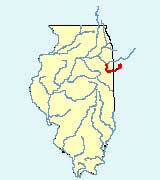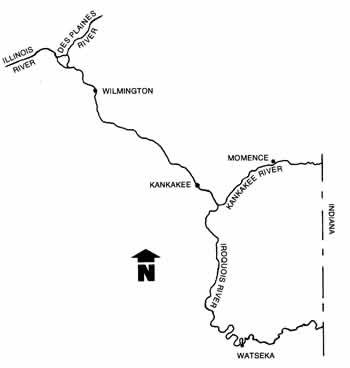Choose another river
Iroquois River


©Illinois State Water Survey
![]() Kankakee-Iroquois River Fishing Guide
Kankakee-Iroquois River Fishing Guide
Description: The Iroquois River originates in Indiana and flows in a northwest direction for 55.4 miles through Illinois to its confluence with the Kankakee River near Aroma Park. The drainage area of the Iroquois River basin is 2137 square miles with 1240 square miles of that area being in Illinois. There are 11 named tributaries to the Iroquois River in Illinois, Spring Creek at 65 miles in length and Sugar Creek at 38.9 miles in length being the two largest. The mainstem Iroquois River is a relatively low gradient, slow moving river that is prone to diatom algae blooms in recent years.
River Information: Sugar Creek is the main tributary to the Iroquois River. It extends South and West through the towns of Woodland, Milford, Stockland and into Indiana. It is suitable for small boats most of the fishing season in the Watseka area. Sugar Creek is a volatile stream that is narrow in some places with very few straight runs making it prone to log jams and strong currents at times. It is not as clear as the Iroquois River, which is evident at the mouth of the two streams. Sugar Creek is great for blue and channel catfish, crappie, walleye, bluegill and smallmouth bass in some places upstream.

The Iroquois River at Watseka running upstream, flows West through the town of Iroquois and into Indiana all the way through Rensselaer. Upstream from Watseka provides excellent fishing, but can be difficult to travel far by boat. The river is narrow upstream from Sugar Creek and can become completely blocked by log jams. There are some places that can be fished from shore. channel catfish, crappie, walleye, smallmouth bass, northern pike, and bluegill can be found. The deep water around Watseka is especially good for channel cat.
The Iroquois River running downstream from Watseka is boatable most of the fishing season. After it picks up Sugar Creek the river widens. There are some sand bars that may make boating difficult when water levels are very low, but there is no blockage. The boat launch at the Plato Bridge provides boating all season. The Iroquois River picks up Spring Creek and Beaver Creek before it empties into the Kankakee River at Aroma Park and retires its name. Great fishing all year with the same fish listed above can be found in this part of the river from Watseka to Aroma Park.
Like the Kankakee, the Iroquois River has not been channelized and retains much of its natural beauty. This river provides an aquatic resource of 2,547 acres.
River Access: The Iroquois River is limited in the number of public access points it has to offer. The only public boat launch on the river is located at the northwest edge of Watseka. The lower parts of the river can be reached by traveling upstream from the public boat launch on the Kankakee River at Aroma Park. There are a few additional bridge crossings and roadside areas that are popular with local residents.
Species |
Rank |
Fish Status |
Average | Bluegill collected in the surveys were found at only two Iroquois River sites and 12 tributary sites. Bluegill were most abundant in Sugar Creek near Stockland. | |
Excellent | Electrofishing surveys in 2010 produced an average 19.8 channel catfish per hour. This excellent catch rate was highlighted by the 74 channel catfish collected at Sugar Island, east of Chebanse. The largest channel catfish of the 2010 surveys was 24 inches, collected from Sugar Creek near Milford. | |
Good | The 2010 surveys produced 44 crappie, with black crappie outnumbering white 39 to 5. Crappie were found at three of the Iroquois River sites and five tributary sites. They were most abundant in the Iroquois River east of Ashkum, with a catch rate of 15 per hour of electrofishing. Beaver Creek and Prairie Creek both produced 10 black crappie. | |
Good | The 2010 electrofishing surveys produced an average of 1.4 flathead catfish per hour of sampling. The largest flathead catfish was a 21-incher collected from the Iroquois River east of Ashkum. | |
Average | The Iroquois River sites produced up to eight largemouth bass, averaging 5.4 per hour of electrofishing in 2010. The tributaries produced an average of 4.1 largemouth bass per site. They were most abundant in Beaver Creek near Papineau. The largest individual was 15.5 inches from the Iroquois River near L’Erable. | |
Average | 11 northern pike were collected in the 2010 surveys. The largest was a 36-inch pike collected from the Iroquois River at Sugar Island. Other locations northern pike were collected include the Iroquois River near the town of Iroquois, Mud Creek near Milford, Sugar Creek near Milford, Spring Creek near Onarga and Crescent City, and Beaver Creek near Papineau. | |
Good | Smallmouth bass are most abundant in Sugar Creek near Milford. The largest smallmouth bass of the 2010 surveys was 14.9 inches, collected from Mud Creek near Stockland. | |
Very Good | The Iroquois River has been stocked annually since 2007, except 2012, with an average of 32,683 walleye. These stockings have created a popular fishery. 11 walleye were collected in the 2010 surveys. The largest walleye collected was a 27-incher from the Iroquois River at Sugar Island. Other locations walleye were collected include the Iroquois River near the town of Iroquois, Pike Creek, Sugar Creek, and Beaver Creek. Regulation: Walleye, sauger, and their hybrids have a 14-inch minimum length limit and a protected slot of 18 to 26 inches, with a 3 fish daily creel limit of which only 1 can be over 26 inches. | |



